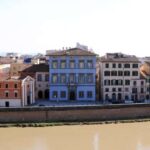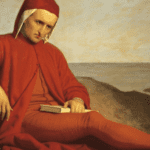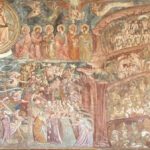The Luminara of San Ranieri. Every year, for the wake of the Patron Saint of Pisa, the Lungarni are festively decorated with thousands of candles that illuminate the streets along the Arno river.
Like every country and city in Italy, Pisa is also full of centuries-old traditions to which the Pisans are very attached and which live with a lot of emphasis.
One of the most evocative celebrations is certainly the Luminara (or Luminaria) of San Ranieri which takes place the night before the feast of the Patron of the city, on June 16.
The June of Pisa
This festival takes place inside the so-called “Giugno Pisano”.
In fact, June is a month for Pisa full of historical celebrations and events that take place not only in the city, but throughout the province.
On the 16th evening we have the Luminara of San Ranieri, while the following day, the day of the patron, a series of liturgical celebrations take place inside the Cathedral. The fair along the historic center and continues in the late afternoon with the Palio remiero that sees the teams of the four neighborhoods compete on the river.
The last Saturday of the month there is the traditional Gioco del Ponte sul Ponte di Mezzo, anticipated by the historic procession with the extras representing the various neighborhoods of the Municipality.
While the Regatta of the Ancient Maritime Republics takes place every year, in rotation, in a different city between Pisa, Amalfi, Venice and Genoa and their representations clash in a rowing competition (on the river, at sea or in the lagoon).
Here too, the historical procession is very rich and particular with over 80 figurants who symbolize the glory and tell the story of their city.
The preparation of the Luminara of San Ranieri
The preparation for the night of the Luminara begins weeks before with the placement of the so-called whitewashed houses, white wooden frames, on the Lungarni palaces that we visit in our Pisano tour.
On the afternoon of the 16th, hundreds of people are in charge of lighting the lights, placing them in special plastic glasses that are placed on the wooden supports that frame windows, doors and canopies.
More than 100 thousand candles are lit that give the city a magical atmosphere, highlighted by the Arno River that reflects its plays of light. All this is emphasized by fireworks, music and light games that start from the river and attract people from all over the region and beyond every year.
Logically it is not to least the most famous area of the city, the famous Piazza dei Miracolida where all our tours start.
Here all the monuments are illuminated by artificial lights (for safety reasons) and the undisputed protagonist certainly remains the Leaning Tower illuminated on all eight floors.
But the tradition of the lights does not fail, in fact along the stretch of walls that surrounds the square, we find the traditional lighting with whitewashers and candles.
Small curiosity: the Tower is illuminated during the year also for other anniversaries and of various colors.
In past years it has been illuminated with purple blue and green for the Day against Rare Diseases on February 29, with green to celebrate St. Patrick’s Day on March 17, with purple for the World Day of Chronic Inflammatory Diseases on May 19, with the Italian tricolor during Easter in lockdown for the CoronaVirus.
The origin of the Luminara of San Ranieri
The Luminara, or the decoration of the city with candles, was not ‘invented’ for the patron saint, in fact we have news of it since 1337.
There were several festive occasions for which this scenographic decoration was used, such as the arrival of Vittoria della Rovere, wife of Grand Duke Ferdinand II, for the Carnival of 1639 and on June 14, 1662 for the arrival of Cosimo III’s wife, Margherita Luisa, passing through Florence.
San Ranieri Life and miracles
As already mentioned, the Patron Saint of Pisa and its Diocese is San Ranieri and his anniversary takes place on June 17 (the day of his death).
His story is narrated by one of his contemporarians, Benincasa, who tells the life and miracles before and after death.
Ranienri was born around 1117 the son of the Scacceri family, merchants of the upper middle class who resided in the neighborhood of Kinzica, or today’s neighborhood of San Martino, South-East area of the city.
He has a carefree, social and full of well-sunity life, until he knows a noble knight, Alberto Leccacapre, who has given up his wealth and well-to-do life to retire to religious life with the monks of the convent of San Vito.
Ranieri takes an example and he too gives up all his own holdings and converts.
Around 1136 he went to the Holy Land with a company of merchants and, determined to give the definitive turn to his life, he dissolved the family merchant society and on the altar of Calvary in the Church of the Holy Sepulchre, lays down his clothes and receives the garment of pilgrim.
He returned to Pisa in 1154 and was lovingly welcomed in the Benedictine monastery of San Vito where he lived until his death, Friday 17 June 1160.
At the beginning of the fourteenth century the body was brought to the Cathedral and here an altar was made for its remains at the intersection of the nave with the left transept, commissioned by Burgundio di Tado to Tino da Camaino.
Only on March 25, 1633 the bones of the Saint are transferred to the new monumental altar in the right transept inside the Coronation Chapel and for this occasion the first Luminara of San Ranieri is celebrated and will be repeated almost every year.
On this day the whole city was festively illuminated to celebrate the Patron Saint who now lies in a glass urn.
Suspension of the Luminara in history
However, there were moments in history when the Luminara was not celebrated, it was abolished in 1867 and restored in 1937 on the occasion of the resumption of the Gioco del Ponte, it was suspended during the Second World War until 1952 and was interrupted between 1966 and 1969, due to the flood of the Arno that caused the destruction of the Solferino Bridge and the Lungarni.
In addition, in 2020 it will not be held due to the health emergency due to the Covid-19 pandemic.







